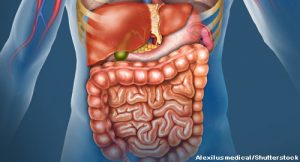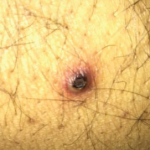 With more than 3.1 million cases of inflammatory bowel disease (IBD) in the U.S., it’s likely most clinicians will encounter many patients with this condition over the course of their careers. Indeed, given the systemic manifestations of IBD, it’s particularly likely rheumatologists will see patients with ulcerative colitis and Crohn’s disease.
With more than 3.1 million cases of inflammatory bowel disease (IBD) in the U.S., it’s likely most clinicians will encounter many patients with this condition over the course of their careers. Indeed, given the systemic manifestations of IBD, it’s particularly likely rheumatologists will see patients with ulcerative colitis and Crohn’s disease.
At the 2021 ACR State-of-the-Art Clinical Symposium, David Rubin, MD, Joseph B. Kirshner professor of medicine and chief of the Section of Gastroenterology, Hepatology and Nutrition, University of Chicago, provided a comprehensive talk on IBD for rheumatologists.
The epidemiology of IBD is fairly evenly split between ulcerative colitis and Crohn’s disease, patients are typically young at the time of diagnosis (i.e., between 15–30 years old), and most patients with IBD don’t have a family history of the condition, Dr. Rubin explained. Interestingly, IBD prevalence is increasing in Western countries, and newly industrialized countries are also experiencing rapidly increasing incidence of IBD.1
The pathogenesis of IBD is believed to involve a combination of genetic factors; environmental factors, such as smoking as a risk factor for Crohn’s disease; microbial dysbiosis, which sometimes occurs after exposure to antibiotics or a gastrointestinal infection; and immune dysregulation.
Dr. Rubin noted several rare, inherited immunodeficiencies greatly resemble IBD, and many treatments for IBD are aimed at immune system modification.
Spondyloarthritis (SpA) is the most frequent extra-intestinal manifestation of IBD and is seen in 10–39% of patients with IBD. This association is more frequently observed in patients with Crohn’s disease than those with ulcerative colitis. When looking at patients with SpA, the prevalence of symptomatic IBD is 6–14%, and it’s more often seen in men and younger patients. Dr. Rubin pointed out that asymptomatic IBD may be present in up to 60% of all patients with ankylosing spondylitis (AS), and 5–20% of patients with AS will develop Crohn’s disease within the first five years of AS presentation.2
Researchers have evaluated potential biomarkers to identify patients with SpA who are at risk of developing IBD. One recent systematic review found fecal calprotectin is a useful, non-invasive biomarker that can help identify at-risk patients.3
Asymptomatic IBD may be present in up to 60% of all patients with ankylosing spondylitis (AS), & 5–20% of patients with AS will develop Crohn’s disease within the first five years of AS presentation.
Management
Dr. Rubin outlined the main goals for clinicians and patients in the management of IBD, including:
- Making a quick and accurate diagnosis;
- Seeking to induce rapid remission of disease to achieve normal bowel function;
- Maintaining steroid-free remission;
- Changing the natural history of IBD to avoid surgery, hospitalizations, disease or drug-related complications; and
- Reducing the overall cost of care to patients and the healthcare system.
As one can see, many of these goals describe a rheumatologist’s approach to the management of systemic autoimmune diseases, such as rheumatoid arthritis (RA) and lupus.
Also similar to modern rheumatic care is the way in which gastroenterologists seek to use a treat-to-target approach, with a combination of laboratory, imaging, histologic and patient-reported outcome measures. Some unique considerations in IBD management are: 1) symptoms do not always correlate with bowel inflammation, 2) anxiety and depression are increased in patients with IBD, 3) surgery is effective, but disease can recur after these interventions, and 4) enteric protein loss can affect the clearance of monoclonal antibodies when they are used for treatment.
Treatment
Several comparative effectiveness studies indicate combined treatment with anti-tumor necrosis factor (TNF) therapy and other immunomodulatory medications may be superior to anti-TNF therapy alone in patients with IBD. In the SONIC trial, more than 500 adults with moderate to severe Crohn’s disease were randomized to receive infliximab monotherapy, azathioprine monotherapy or combination treatment with both medications. At week 26 of follow-up, 57% of patients in the combination group achieved steroid-free remission vs. 44% in the infliximab monotherapy group and 30% in the azathioprine monotherapy group.4 Similar results favoring combination therapy with infliximab and azathioprine were seen in the UC SUCCESS trial.5
Several anti-integrin treatments, namely natalizumab and vedolizumab, have become part of the treatment armamentarium for IBD. These medications show promise in helping prevent or reduce severity of arthritis and arthralgias in many patients with IBD. In a post hoc analysis of data from the GEMINI studies—the phase 3 trials evaluating vedolizumab for the treatment of ulcerative colitis and Crohn’s disease—vedolizumab was significantly less likely than placebo to be associated with new or worsening arthritis or arthralgias in patients with Crohn’s disease.6
Janus kinase (JAK) inhibitors have also started to gain attention as potential treatments for the gastrointestinal and arthritic complications of IBD. A unique dose of the JAK inhibitor tofacitinib has been used to treat patients with ulcerative colitis, with an induction regimen of 10 mg orally twice per day for eight weeks, followed by a maintenance dose of 5 mg twice per day, which can be increased to 10 mg twice per day if needed. Because JAK inhibitors have quickly become a treatment of choice for many patients with RA, these medications may also become potential options to target the joint and gut manifestations of IBD.
In the final portion of the talk, Dr. Rubin discussed the importance and use of trough levels—the lowest concentration reached by a drug before the next dose is administered and the level frequently used for therapeutic monitoring. He noted that trough levels of medications used in the treatment of IBD correlate well with clinical response. In other words, higher trough levels of a medication are associated with improved control of IBD in patients, and consistently lower trough levels are associated with worse control.
He provided data on this observation for infliximab, adalimumab, certolizumab and vedolizumab. To date, trough levels have been used predominantly for reactive assessments after loss of response to a biologic medication.
An ongoing debate concerns whether proactive drug monitoring is cost effective and improves outcomes for patients, and if such monitoring should be incorporated into routine clinical practice. Several factors, such as the formation of anti-drug antibodies, concomitant use of other immunosuppressants, baseline level of TNF- α in the serum of patients, hypoalbuminemia and body mass index, can affect the pharmacokinetics of monoclonal antibodies. Dr. Rubin said all these factors should be considered when evaluating efficacy and the potential for loss of electiveness of biologics in treating patients with IBD.
Dr. Rubin ended his talk by imploring the audience to be cognizant of warning signs of IBD, such as changes in bowel habits, blood in the stool, nocturnal symptoms and unintentional weight loss. Additionally, anemia and low levels of vitamin B12, vitamin D and albumin may all be indicators of IBD.
Only through astute, thorough clinical evaluation and by working together to identify and treat IBD and its myriad manifestations will rheumatologists and gastroenterologists be able to help patients.
Jason Liebowitz, MD, completed his fellowship in rheumatology at Johns Hopkins University, Baltimore, where he also earned his medical degree. He is currently in practice with Skylands Medical Group, N.J.
References
- Kaplan GG, Ng SC. Understanding and preventing the global increase of inflammatory bowel disease. Gastroenterology. 2017 Feb;152(2):313–321.e2. Erratum: Gastroenterology. 2017 Jun;152(8):2084. PMID: 27793607.
- Fragoulis GE, Liava C, Daoussis D, et al. Inflammatory bowel diseases and spondyloarthropathies: From pathogenesis to treatment. World J Gastroenterol. 2019 May 14;25(18):2162–2176.
- Fauny M, D’Amico F, Bonovas S, et al. Faecal calprotectin for the diagnosis of bowel inflammation in patients with rheumatological diseases: A systematic review. J Crohns Colitis. 2020 Jun 19;14(5):688–693.
- Colombel JF, Sandborn WJ, Reinisch W, et al. Infliximab, azathioprine or combination therapy for Crohn’s disease. N Engl J Med. 2010 Apr 15;362(15):1383–1395.
- Panaccione R, Ghosh S, Middleton S, et al. Combination therapy with infliximab and azathioprine is superior to monotherapy with either agent in ulcerative colitis. Gastroenterology. 2014 Feb;146(2):392–400.e3.
- Feagan BG, Sandborn WJ, Colombel JF, et al. Incidence of arthritis/arthralgia in inflammatory bowel disease with long-term vedolizumab treatment: Post hoc analyses of the GEMINI trials. J Crohns Colitis. 2019 Jan 1;13(1):50–57.

